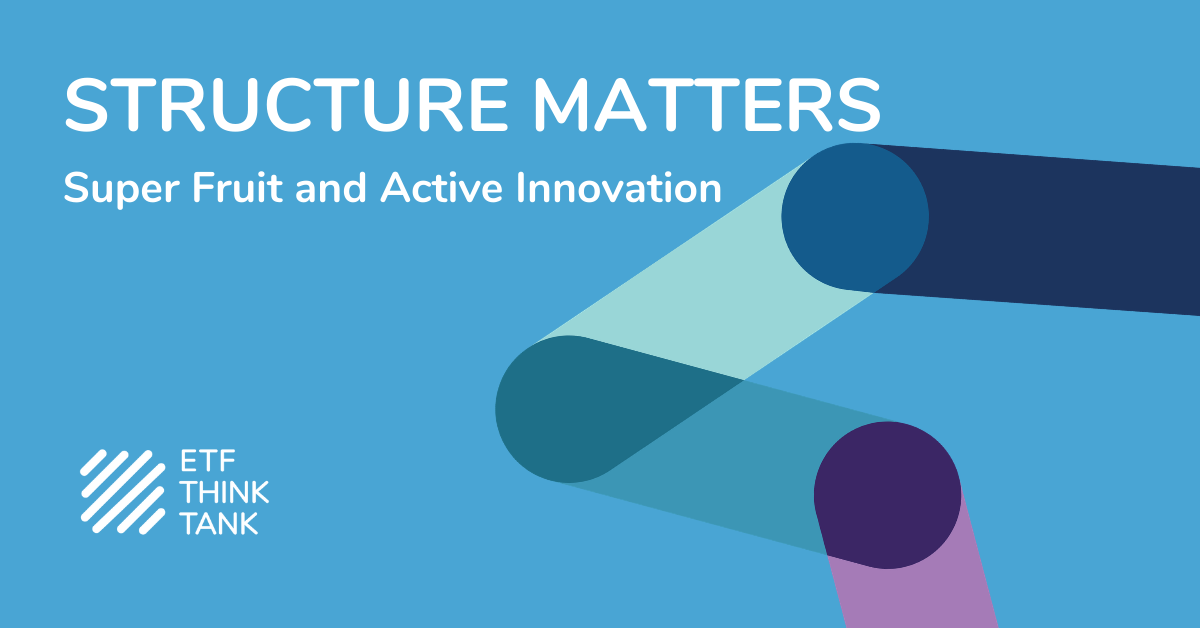Over the past few weeks, we covered the discounts in Bond ETFs and the Fire Sale in all Assets. This week, we return to more traditional ETF research. ETFGI noted that active ETFs in the US celebrated a 12th anniversary last week:
With ETF innovation like active ETFs in mind, we are offering a preview of the introduction to our upcoming white paper by ETF Think Tank contributor, Dan Weiskopf (@ETFprofessor on Twitter).
Measuring Innovation in the ETF Industry
ETF Think Tank research tracks ETF asset growth at about a 19% annual rate due to two primary factors:
- Client Alignment Growth Factors (Low Cost, Tax Efficiency, Transparency and Liquidity)
- Innovation Growth Factors (Access, Alpha Generation and Active Implementation)
In this paper, we review the factors that are likely to drive future ETF growth by evaluating how the factors in the past decade have evolved.
For many investors, the client alignment growth factor of low cost is seen as the primary driver of ETF asset growth. However, in this paper, using December 31, 2019 year-end data, we look back at the top 20 ETFs launched each year, as measured by current assets under management (AUM), for the past decade and categorize them between low cost solutions and innovation growth factors.[1] The data shows that innovation growth factors, like access, alpha generation and actively managed, are now becoming key to the future success of the ETF industry. Most importantly, the data highlights a new key performance indicator (KPI) called the “Annual Client Alignment to Innovation (ACAI).” No, it is not a super fruit, but rather a measure of the 20 most successful ETFs launched each calendar year. ACAI compares the ratio of launches and AUM from client alignment factors, like low cost, to innovation factors like alpha generation.
In many ways, this is the essence of the meaning behind the utility value of the label Smart Beta, or what we refer to in the ETF Think Tank – Non-Traditional ETFs. Developing the right nomenclature to describe innovation in Non-Traditional or Smart Beta ETFs requires some consistency of definitions. To that point, for purposes of this study I have used the acronym AAA: Access (first to provide), Alpha Generation and Active, as a catch all for ETFs that have succeeded through innovation. From an investor’s standpoint, I think of the use of smart beta as a “smart bet on AAA”.
These are the three elements that define the utility value for an ETF investor who cares to seek value through security selection over low cost broad market exposure. For purposes of measuring innovation, we argue that active vs. systematic rules are not different for the investor’s purposes because the utility value is simply the access. The trend is clear – although liquidity and low-cost factors drove the first wave of ETF success from 1995 to 2009, innovation has been a greater driver of success for ETFs launched in the past decade.
[1] Bloomberg and ETF Think Tank Master database

Defining the Data Set
By measuring the yearly progress of innovation using the acronym ACAI as the KPI that tracks ETF innovation, both in terms of numbers and AUM relative to low cost, investors begin to see how the ETF market is expanding and innovating. To be clear, the terms ACAI Number and ACAI AUM are used to illustrate the ratios. AAA and Innovation Growth Factors are used interchangeably.
In isolating new launches deemed as strictly Low Cost solutions, for the purpose of this paper, we focus on ETFs offering traditional broad market weighted ETFs with low active-share that provide reduced cost access similar to existing products. Given the evolution of competing strictly on expense ratio, we can expect that the ACAI ratios will consistently increase with market dynamics, thereby highlighting how innovation is developing in a dynamic manner. For example, using the data from the 2019 ACAI report shows that 94% of the launches in the Top 20 are defined by one of the 3 Growth factors.
Most importantly, using this definition, it is evident that the ACAI AUM has risen from 14.8% to 98.5% over the past 8 years. Moreover, the window for specifically low-cost ETFs is shrinking. In the last few years, the number of strictly focused, low price (expense ratio) competing ETFs have drastically declined due to the need for quick scale. As a result, the number of ETFs in the Top 20, offering differentiation through innovation or AAA, has steadily increased, and so has the percentage of AUM going into this category. The fact is that AAA ETFs are in fashion because risk management, access seeking, and/or target active share is needed by certain investors. The chart below shows how the assets associated with innovation have jumped 6 fold between 2009 and 2019. This is an important trend because it is the beginning of large institutions, as fiduciaries, pensions and endowments, embracing the value of an ETF as simply an efficient investment delivery tool that serves the needs of their beneficiaries.
















